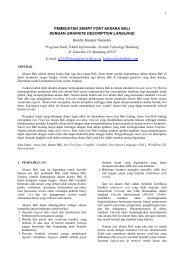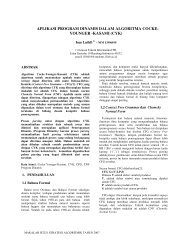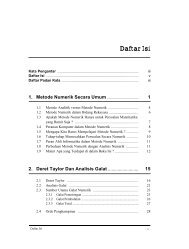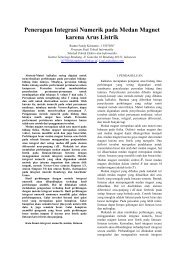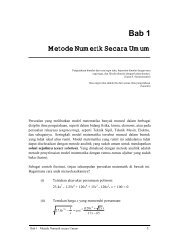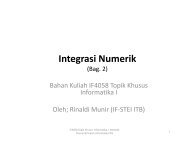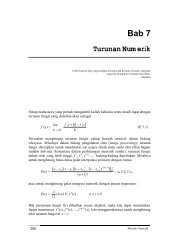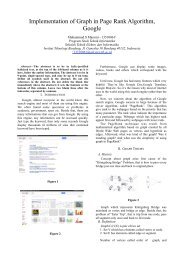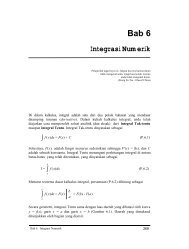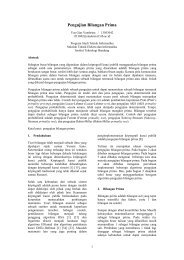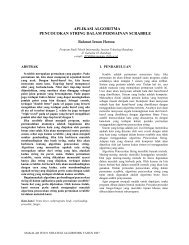IEEE Paper Template in A4 (V1) - ITB
IEEE Paper Template in A4 (V1) - ITB
IEEE Paper Template in A4 (V1) - ITB
You also want an ePaper? Increase the reach of your titles
YUMPU automatically turns print PDFs into web optimized ePapers that Google loves.
Arithmetic Cod<strong>in</strong>g Modification to Compress SMS<br />
Ario Yudo Husodo #1 , R<strong>in</strong>aldi Munir *2<br />
#* Informatics Department, School of Electrical Eng<strong>in</strong>eer<strong>in</strong>g and Informatics, Institut Teknologi Bandung<br />
Abstract— This paper proposes an effective method to compress<br />
SMS by do<strong>in</strong>g some modifications to arithmetic cod<strong>in</strong>g data<br />
compression mechanism. The aim of this proposal is to optimize<br />
the maximum character capacity of SMS body. Every character<br />
<strong>in</strong> SMS is mostly encoded <strong>in</strong> 7 bit and the maximum capacity of<br />
one SMS is only 1120 bit. Those SMS characteristics require a<br />
very efficient compression method to compress SMS.<br />
Arithmetic cod<strong>in</strong>g is a compression mechanism that works by<br />
convert<strong>in</strong>g a data message to a real code number between 0 and 1.<br />
Arithmetic cod<strong>in</strong>g provides nearly optimal data compression.<br />
However, it requires additional memory space <strong>in</strong> compresseddata<br />
to save arithmetic cod<strong>in</strong>g probability table for<br />
decompress<strong>in</strong>g the compressed-data. Besides, it requires highprecision<br />
and effective encoder-decoder to calculate and<br />
represent its code number (compressed-data).<br />
In very limited data space like SMS, the need of additional<br />
memory space to save arithmetic cod<strong>in</strong>g probability table is<br />
<strong>in</strong>efficient. It will make the compressed-SMS size bigger than the<br />
orig<strong>in</strong>al SMS (uncompressed SMS) size. To overcome this<br />
<strong>in</strong>efficiency, <strong>in</strong> this paper, the need of memory space is erased.<br />
This paper proposes semi dynamic probability table usage to<br />
compress and decompress SMS for overcom<strong>in</strong>g the <strong>in</strong>efficient<br />
need of memory space. To more optimize the effectiveness and<br />
efficiency of proposed-method compression ratio, this paper also<br />
proposes a smart data representation to represent code number<br />
so that the number of bits needed to represent compressed-SMS<br />
can be well-m<strong>in</strong>imized. By us<strong>in</strong>g this smart data representation,<br />
2k digit decimal code number value <strong>in</strong> base-10 can be written by<br />
only us<strong>in</strong>g k default GSM 7 bit characters.<br />
The proposed compression mechanism <strong>in</strong> this paper has been<br />
researched pla<strong>in</strong>ly <strong>in</strong> mobile phone that uses Android operat<strong>in</strong>g<br />
system. The SMS data test language used on the research is<br />
Bahasa Indonesia. Based on the research, the compression ratio<br />
of proposed compression mechanism is vary depends on the<br />
content of SMS. The average compression ratio of proposed<br />
compression mechanism is 71%, while the maximum<br />
compression ratio is able to reach less than 25%, i.e. 500<br />
character SMS can be compressed to 121 character SMS.<br />
Keywords — arithmetic cod<strong>in</strong>g, modification, SMS, compression.<br />
A. Arithmetic Cod<strong>in</strong>g<br />
I. INTRODUCTION<br />
Arithmetic cod<strong>in</strong>g is a compression mechanism that works<br />
by convert<strong>in</strong>g a data message to a real code number between 0<br />
and 1 [1]. To compress a data, arithmetic cod<strong>in</strong>g requires a<br />
probability table of characters conta<strong>in</strong>ed <strong>in</strong> the data.<br />
Probability table is a table conta<strong>in</strong><strong>in</strong>g probability range of<br />
Jalan Ganesha 10 Bandung<br />
if17017@students.if.itb.ac.id<br />
r<strong>in</strong>aldi@<strong>in</strong>formatika.org<br />
exist<strong>in</strong>g characters <strong>in</strong> a data which is built based on the<br />
exist<strong>in</strong>g characters frequency <strong>in</strong> the data itself. The smaller the<br />
range to generate code number, the higher bit number is<br />
needed to represent the code number [2]. Arithmetic cod<strong>in</strong>g<br />
only needs usual arithmetic operation to compress and<br />
decompress a message. On arithmetic cod<strong>in</strong>g, compression<br />
encod<strong>in</strong>g is not done to every s<strong>in</strong>gle character but it is done<br />
straight to the message itself. Basically, arithmetic cod<strong>in</strong>g is<br />
able to compress a message with compressed-message result<br />
near to the message entropy value.<br />
There are two ma<strong>in</strong> weaknesses of arithmetic cod<strong>in</strong>g. The<br />
first one is that it needs memory space <strong>in</strong> compressed-data to<br />
save its range probability table for decompress<strong>in</strong>g the<br />
compressed-data. If arithmetic cod<strong>in</strong>g is used to compressed<br />
small-size data, the existence of the range probability table <strong>in</strong><br />
compressed-data will make the compressed-data bigger <strong>in</strong> size<br />
than the orig<strong>in</strong>al data itself. The second weakness of<br />
arithmetic cod<strong>in</strong>g is that it requires encoder-decoder with<br />
high-precision value. Encoder is a mach<strong>in</strong>e to compress a<br />
message; meanwhile decoder is a mach<strong>in</strong>e to decompress a<br />
compressed-message. If encoder or decoder doesn‘t have<br />
ability to calculate long mantissa with precision value, the<br />
decompressed message of compressed-message can be<br />
different from the orig<strong>in</strong>al message.<br />
B. Short Message Service (SMS)<br />
Short Message Service (SMS) is a bi-directional<br />
communication service to send a text message via wireless<br />
communication system. The common SMS uses default GSM<br />
7 bit alphabet encod<strong>in</strong>g system. The maximum capacity of a<br />
SMS is 1120 bits [3]. It means that it is only able to conta<strong>in</strong><br />
maximum 160 standard characters encoded by default GSM 7<br />
bit alphabet. Nowadays, there are three ma<strong>in</strong> encod<strong>in</strong>g<br />
systems for SMS: the default GSM 7-bit alphabet, the 8-bit<br />
data alphabet, and the 16-bit UTF-16 alphabet. No matter the<br />
encod<strong>in</strong>g system used to encode SMS characters, the<br />
maximum capacity of usual SMS is only 1120 bits.<br />
There are two ma<strong>in</strong> parts of SMS, first is header, and<br />
second is body. SMS header consists of <strong>in</strong>struction sets related<br />
to components work<strong>in</strong>g on SMS service network, like receiver<br />
dest<strong>in</strong>ation number and date <strong>in</strong>formation about the time when<br />
SMS is sent. In another hand, SMS body is a part of SMS<br />
conta<strong>in</strong><strong>in</strong>g the ma<strong>in</strong> message that SMS sender want to send.<br />
Because the part of SMS header must be readable by SMS<br />
provider and because the most SMS encod<strong>in</strong>g system<br />
nowadays uses default GSM 7 bit alphabet, this paper will<br />
only cont<strong>in</strong>ue discussion on an efficient method to compress
SMS body that uses default GSM 7 bit alphabet. To facilitate<br />
the easy call of proposed SMS compression mechanism <strong>in</strong> this<br />
paper, the proposed mechanism is named with ACHA, stand<br />
for Arithmetic Cod<strong>in</strong>g Hybrid Ario.<br />
II. PROPOSED SMS COMPRESSION MECHANISM<br />
In mak<strong>in</strong>g an efficient method to compress SMS body, two<br />
modification aspects of arithmetic cod<strong>in</strong>g are proposed <strong>in</strong> this<br />
paper.<br />
A. Semi Dynamic Probability Table Usage<br />
Every compression mechanism needs conversion table to<br />
compress and decompress a data. Usually, this conversion<br />
table built based on the data message itself. In pure arithmetic<br />
cod<strong>in</strong>g mechanism, the conversion table often called range<br />
probability table. Because the range probability table adapts to<br />
orig<strong>in</strong>al data content, the range probability <strong>in</strong> arithmetic<br />
cod<strong>in</strong>g is also often called with dynamic range probability<br />
table. In arithmetic cod<strong>in</strong>g mechanism, to decompress a<br />
compressed-message correctly (match with orig<strong>in</strong>al message),<br />
decoder needs the same range probability table used by<br />
encoder when encoder compress<strong>in</strong>g the orig<strong>in</strong>al message. To<br />
enable decoder hav<strong>in</strong>g the same range probability table,<br />
usually the range probability used by arithmetic cod<strong>in</strong>g<br />
encoder is sent along with the compressed-data. Usually, the<br />
range probability is <strong>in</strong>cluded <strong>in</strong> the beg<strong>in</strong>n<strong>in</strong>g of compresseddata<br />
and it is called with compressed-data header.<br />
For compress<strong>in</strong>g a big-size data by us<strong>in</strong>g arithmetic cod<strong>in</strong>g<br />
mechanism, the compressed-data header doesn‘t give any<br />
significant difference of compressed-data size. But if the<br />
orig<strong>in</strong>al data size is small, the existence of the compresseddata<br />
header can add very significant difference of compresseddata<br />
size. It could enlarge the compression ratio of a data<br />
message significantly. Compression ratio is a ratio between<br />
compressed-data size compared to orig<strong>in</strong>al-data size. The<br />
smaller compression ratio of a compression mechanism, the<br />
better performance of the compression mechanism is.<br />
Compression Ratio =<br />
Because SMS body only have maximum capacity of 1120<br />
bit characters, SMS can be categorized as a small-size data<br />
message. It means that if SMS is compressed by us<strong>in</strong>g pure<br />
arithmetic cod<strong>in</strong>g mechanism, addition of compressed-data<br />
header is able to make the compressed-SMS size bigger than<br />
the orig<strong>in</strong>al-SMS size. To overcome this problem, the<br />
existence of compressed-data header should be erased.<br />
The most conventional way for eras<strong>in</strong>g the existence of<br />
compressed-data header is by us<strong>in</strong>g static range probability<br />
table to compress any SMS body. It means that encoder and<br />
decoder use one-fit-all table to compress and decompress any<br />
k<strong>in</strong>d of SMS body. This method is very simple but the<br />
efficiency of arithmetic cod<strong>in</strong>g mechanism will be decreased<br />
drastically. The decreased of arithmetic cod<strong>in</strong>g efficiency<br />
occurs because the one-fit-all table also conta<strong>in</strong>s range<br />
probability data of characters that do not exist <strong>in</strong> the orig<strong>in</strong>al<br />
SMS body. This data def<strong>in</strong>itely decrease the table range to<br />
generate code number, <strong>in</strong> another word, this data will <strong>in</strong>crease<br />
the bit number needed to represent the code number.<br />
To overcome the weaknesses of dynamic and static range<br />
probability table, this paper proposed-mechanism –ACHA–<br />
proposes a semi-dynamic range probability table for<br />
compress<strong>in</strong>g and decompress<strong>in</strong>g SMS. Semi dynamic range<br />
probability table is a dynamic range probability table that is<br />
built from some static range probability sub table. A static<br />
range probability sub table consists of static characters<br />
frequency that is predicted (based on probability and statistical<br />
calculation) will appear <strong>in</strong> orig<strong>in</strong>al SMS. Different from<br />
conventional static range probability table, a static range<br />
probability sub table doesn‘t conta<strong>in</strong> data frequency of all<br />
characters that possible to appear <strong>in</strong> orig<strong>in</strong>al SMS, it only<br />
conta<strong>in</strong>s data frequency of some characters that possible to<br />
appear <strong>in</strong> orig<strong>in</strong>al SMS. Data <strong>in</strong> a static range probability sub<br />
table is a part of data <strong>in</strong> usual static range probability table.<br />
In ACHA mechanism, data <strong>in</strong> conventional static range<br />
probability table is divided to n ACHA static range probability<br />
sub tables (the number of n will be discussed later). Every<br />
s<strong>in</strong>gle ACHA static range probability sub table conta<strong>in</strong><br />
almost-equal number of data. Any s<strong>in</strong>gle data conta<strong>in</strong>ed <strong>in</strong><br />
ACHA static range probability sub table-j is never conta<strong>in</strong>ed<br />
<strong>in</strong> ACHA static range probability sub table-k, where j ≠ k. In<br />
ACHA mechanism, the ma<strong>in</strong> range probability table for<br />
compress<strong>in</strong>g and decompress<strong>in</strong>g SMS is built from the<br />
suitable ACHA static range probability sub tables.<br />
In ACHA mechanism, after encoder reads the whole SMS<br />
body, encoder determ<strong>in</strong>es which ACHA sub tables (ACHA<br />
static range probability sub tables) should be used to build<br />
ma<strong>in</strong> range probability table. The configuration of ACHA sub<br />
tables used by encoder to compress orig<strong>in</strong>al data is written<br />
only by us<strong>in</strong>g few characters (default GSM 7 bit character) –<br />
these characters are called Conf_Char (configuration<br />
character). After decid<strong>in</strong>g the ACHA sub tables‘ configuration,<br />
ACHA build the ma<strong>in</strong> range probability table then encoder<br />
starts compression process just like common arithmeticcod<strong>in</strong>g<br />
compression mechanism. In the end of compression<br />
process, encoder put the Conf_Char <strong>in</strong> the beg<strong>in</strong>n<strong>in</strong>g of<br />
compressed-data as a part of the compressed-SMS body.<br />
When compressed-SMS received by decoder, decoder read<br />
the Conf_Char, then decoder <strong>in</strong>terprets the Conf_Char to build<br />
ma<strong>in</strong> range probability table to decode the whole compressed-<br />
SMS. After the ma<strong>in</strong> range probability table is built from<br />
ACHA sub tables based on Conf_Char, decoder decompresses<br />
the compressed-SMS just like common arithmetic-cod<strong>in</strong>g<br />
decompression mechanism.<br />
If there are n ACHA sub tables, then call each ACHA sub<br />
tables T1, T2, .., and Tn. To build the ma<strong>in</strong> range probability<br />
table, each ACHA sub tables only has two possibilities: to be<br />
used as part of the ma<strong>in</strong> range probability table or not. Based<br />
on that fact, for n ACHA sub tables, there are 2 n possibilities<br />
of sub table configuration used on build<strong>in</strong>g the ma<strong>in</strong> range<br />
probability table. In ACHA mechanism, the configuration is<br />
represented by efficient Conf_Char (The representation<br />
process of Conf_Char will be discussed <strong>in</strong> section II.B).
To more understand the ACHA sub table mechanism, take<br />
a situation that we want to compress SMS <strong>in</strong> Bahasa Indonesia<br />
with message ―ayah saya‖ (means ―my father‖ <strong>in</strong> English). To<br />
simplify the calculation, assume we only have 16 recognized<br />
letters <strong>in</strong> SMS: {,a,d,e,f,g,h,i,j,m,o,s,y,z,1,2} with<br />
conventional static data frequency of each characters is shown<br />
<strong>in</strong> Table 1. Table 1 shows the simulated average probability of<br />
each 16-character appearance number <strong>in</strong> 10,000 characters<br />
conta<strong>in</strong>ed <strong>in</strong> SMS. Take the number of ACHA sub tables is 4.<br />
The four ACHA sub tables is Shown <strong>in</strong> Table 2, where each<br />
sub tables data is sorted by the characters frequency. Table 3<br />
shows the overall ma<strong>in</strong> range probability used to compress<br />
message ―ayah saya‖.<br />
TABLE I<br />
SIMULATED AVERAGE PROBABILITY APPEARANCE NUMBER OF 16-<br />
RECOGNIZED CHARACTER IN 10,000 CHARACTERS IN SMS<br />
Character Frequency<br />
1500<br />
a 1400<br />
s 1000<br />
d 900<br />
e 900<br />
f 800<br />
g 700<br />
i 600<br />
TABLE 2<br />
ACHA SUB TABLES FOR TABLE 1<br />
Sub Table T1 Sub Table T2<br />
Character Frequency<br />
1500<br />
a 1400<br />
s 1000<br />
d 900<br />
Sub Table T3 Sub Table T4<br />
Character Frequency<br />
m 600<br />
h 500<br />
o 500<br />
y 400<br />
TABLE 3<br />
MAIN CHARACTER FREQUENCY TABLE FROM TABLE 2 TO COMPRESS<br />
MESSAGE ―AYAH SAYA‖<br />
Character Frequency<br />
1500<br />
a 1400<br />
s 1000<br />
d 900<br />
m 600<br />
h 500<br />
o 500<br />
y 400<br />
Character Frequency<br />
m 600<br />
h 500<br />
o 500<br />
y 400<br />
1 50<br />
j 50<br />
2 50<br />
z 50<br />
Character Frequency<br />
e 900<br />
f 800<br />
g 700<br />
i 600<br />
Character Frequency<br />
1 50<br />
j 50<br />
2 50<br />
z 50<br />
From Table 3, to compress ―ayah saya‖, there are only two<br />
ACHA sub tables used to compress the message: T1 and T3.<br />
There is no character <strong>in</strong> T2 or T4 used <strong>in</strong> orig<strong>in</strong>al message<br />
―ayah saya‖, so T2 and T4 is not used to build the ma<strong>in</strong><br />
character frequency table (Table 3). Compared with Table 1<br />
where there are 16 data frequency saved, Table 3 only saves 8<br />
data frequency. It means that the usage of ACHA sub tables<br />
elim<strong>in</strong>ate significantly unused data frequency <strong>in</strong> ma<strong>in</strong><br />
probability table for compress<strong>in</strong>g or decompress<strong>in</strong>g data. By<br />
implement<strong>in</strong>g the ACHA semi-dynamic range probability<br />
table usage, the range to generate code number <strong>in</strong> ACHA<br />
mechanism will be bigger than the range <strong>in</strong> static range<br />
probability method, thus the bit number needed to represent<br />
the code number <strong>in</strong> ACHA will be more efficient than <strong>in</strong> static<br />
range probability method. Table 4 shows the overall ma<strong>in</strong><br />
range probability table used to compress message ―ayah saya‖.<br />
After the ma<strong>in</strong> range probability table –Table 4– built,<br />
encoder starts compression process just like common<br />
arithmetic-cod<strong>in</strong>g compression mechanism.<br />
TABLE 4<br />
MAIN RANGE PROBABILITY TABLE FROM TABLE 3 TO COMPRESS MESSAGE<br />
―AYAH SAYA‖<br />
Character Probability Range<br />
Low<br />
Range<br />
High<br />
Range<br />
1500/6800 0.00 – 0.2206 0.00 0.2206<br />
a 1400/6800 0.2206 – 0.4265 0.2206 0.4265<br />
s 1000/6800 0.4265 – 0.5735 0.4265 0.5735<br />
d 900/6800 0.5735 – 0.7058 0.5735 0.7058<br />
m 600/6800 0.7058 – 0.794 0.7058 0.794<br />
h 500/6800 0.794 – 0.8675 0.794 0.8675<br />
o 500/6800 0.8675 – 0.941 0.8675 0.941<br />
y 400/6800 0.941 – 1.00 0.941 1.00<br />
B. Smart Compressed-Data Representation<br />
In arithmetic cod<strong>in</strong>g mechanism, a data is converted to a<br />
decimal code number. The longer the orig<strong>in</strong>al message, the<br />
more mantissa needed to represent the compressed-message is.<br />
Primitive data structures such float or double practically is not<br />
good to be used as the code number type. The reason is<br />
because the both primitive data structures have limitation <strong>in</strong><br />
number of mantissa they saves, besides, the mantissa precision<br />
they saved is not very precise.<br />
The implementation target of ACHA mechanism is<br />
Android-operat<strong>in</strong>g-system-base mobile phone. Because<br />
Android use java programm<strong>in</strong>g language, to represent long<br />
code number precisely, ACHA mechanism use BigDecimal<br />
java class. The BigDecimal java class is a class that<br />
theoretically can keep unlimited mantissa value of a decimal<br />
number. Unfortunately, the decimal number represented by<br />
BigDecimal java class is encoded as str<strong>in</strong>g. Because of the<br />
limited number of bits conta<strong>in</strong>ed <strong>in</strong> one SMS (1120 bits),<br />
there is only short java str<strong>in</strong>g that can be saved <strong>in</strong> one SMS.
To <strong>in</strong>crease the number of BigDecimal code number value<br />
that can be saved <strong>in</strong> one SMS, the BigDecimal code number<br />
value should be represented more efficiently. In ACHA<br />
mechanism, to represent the code number, ACHA <strong>in</strong>troduce<br />
base-100 number that can be encoded by us<strong>in</strong>g default GSM 7<br />
bit alphabet. By the base-100 number <strong>in</strong>troduced <strong>in</strong> ACHA,<br />
every two number of mantissa <strong>in</strong> BigDecimal code number<br />
will be converted to a base-100 number encoded <strong>in</strong> default<br />
GSM 7 bit alphabet. In ACHA, the converted BigDecimal<br />
code number is called with Encoded Code Number. For<br />
example, if number 91 <strong>in</strong> base-10 number is represented with<br />
Ü <strong>in</strong> base-100 number and number 23 <strong>in</strong> base-10 number is<br />
represented with M <strong>in</strong> base-100 number, then BigDecimal<br />
code number ―0.9123‖ can be written as ÜM <strong>in</strong> compressed<br />
a) ACHA Compression Scheme<br />
Scheme<br />
Fig. 1 ACHA Overall Process Scheme<br />
SMS. Note that either Ü or M can be encoded only by us<strong>in</strong>g 7<br />
bits <strong>in</strong> default GSM 7-bit alphabet encod<strong>in</strong>g system. By us<strong>in</strong>g<br />
<strong>in</strong>troduced base-100 number encoded <strong>in</strong> default GSM 7 bit<br />
alphabet encod<strong>in</strong>g system, ACHA mechanism can represent<br />
2k digit mantissa of BigDecimal code number by only us<strong>in</strong>g k<br />
default GSM 7-bit characters.<br />
Introduced base-100 number is also used to represent<br />
Conf_Char. Recall the discussion <strong>in</strong> section II.A, there are 2 n<br />
possible sub table configurations from n ACHA sub tables.<br />
Base-100 number is able to be used to represent all those<br />
possible configurations. The number of character needed to<br />
represent Conf_Char depends on the number of ACHA sub<br />
tables used. For example, if ACHA sub tables used are 6, then<br />
there are 2 6 = 64 possible configurations. One base-100<br />
b) ACHA Decompression Scheme
number (one Conf_Char) is enough to represent all those<br />
possible configurations. Meanwhile, if ACHA sub tables used<br />
are 8, then there are 2 8 = 256 possible configurations. Then it<br />
means that it needs at least two base-100 numbers (two<br />
Conf_Char) to represent all possible configurations. Because<br />
of this smart compressed-data representation, ACHA<br />
mechanism can represent any <strong>in</strong>formation of compressed-<br />
SMS especially the code number very efficiently. Fig 1 shows<br />
the overall process of ACHA mechanism.<br />
III. RELATED WORK<br />
ACHA compression mechanism is adapted from hybrid<br />
compression mechanism us<strong>in</strong>g codebooks conta<strong>in</strong><strong>in</strong>g k static<br />
codes used by IBM‗s ―Information Management System‖<br />
(IMS) [2] –with some modified method elaboration. In IBM-<br />
IMS, there are k static compression codes to compress a<br />
particular character; meanwhile <strong>in</strong> ACHA there are n static<br />
sub tables used to build ma<strong>in</strong> conversion table (range<br />
probability table) to build compressed-data (code number).<br />
While <strong>in</strong> IBM-IMS the compression-code has been statically<br />
def<strong>in</strong>ed, <strong>in</strong> ACHA it is the sub table characters frequency that<br />
is statically def<strong>in</strong>ed. The compression-code <strong>in</strong> ACHA is<br />
always dynamic depends on the variety of characters <strong>in</strong><br />
orig<strong>in</strong>al data. If the characters-variety <strong>in</strong> orig<strong>in</strong>al data changes,<br />
the ACHA sub tables needed to compress the orig<strong>in</strong>al data<br />
will probably change too, thus the ma<strong>in</strong> range probability<br />
table will also change, as the result, the overall compressioncode<br />
will be different too.<br />
IV. PROPOSED METHOD EFFECTIVENESS<br />
In ACHA, the overall compressed-SMS is written us<strong>in</strong>g<br />
standard default GSM 7-bit characters, it means that every<br />
character written <strong>in</strong> compressed-SMS can be read correctly by<br />
receiver phone (decoder), thus, there is no worry about<br />
unreadable characters <strong>in</strong> receiver phone. In ACHA mechanism,<br />
theoretically the more number of ACHA sub tables, the better<br />
ACHA compression ratio is. It happens because when number<br />
of ACHA sub tables <strong>in</strong>crease, the number of unnecessary data<br />
frequency <strong>in</strong> ma<strong>in</strong> range probability table can be decreased.<br />
For example, if <strong>in</strong> Table 2 there are 16 sub tables (each sub<br />
tables consists of one s<strong>in</strong>gle data frequency), it means to<br />
compress ―ayah saya‖ there is only 5 data saved <strong>in</strong> the ma<strong>in</strong><br />
range probability table. However, if the number of ACHA sub<br />
tables used <strong>in</strong>creases, the number of Conf_Char needed will<br />
<strong>in</strong>crease too. To f<strong>in</strong>d the best compression ratio of ACHA<br />
mechanism, obviously the best number of ACHA sub table<br />
used <strong>in</strong> ACHA mechanism must be found.<br />
Because the proposed SMS-compression mechanism <strong>in</strong><br />
this paper is quite new to compress SMS, the research to f<strong>in</strong>d<br />
the best number of ACHA sub table that should be used is still<br />
under observation. Although the best compression ratio of the<br />
proposed SMS-compression mechanism is still under<br />
observation, the effectiveness of the proposed mechanism has<br />
been tested well.<br />
V. IMPLEMENTATION<br />
To observe ACHA performance, the proposed mechanism<br />
has been implemented <strong>in</strong> mobile phone us<strong>in</strong>g Android<br />
operat<strong>in</strong>g system. The implementation has been done <strong>in</strong><br />
Samsung Galaxy Tab (processor Cortex A-8 1GHz and<br />
512MB of RAM). Fig 2 shows the <strong>in</strong>terface of application<br />
implement<strong>in</strong>g ACHA that is tested <strong>in</strong> Galaxy Tab.<br />
><br />
><br />
Fig. 2 ACHA Application Interface<br />
VI. EXPERIMENTS AND RESULTS<br />
The effectiveness of ACHA mechanism has been tested to<br />
compress 150 diverse SMS us<strong>in</strong>g Bahasa Indonesia. So far,<br />
the research has just tested the ACHA effectiveness us<strong>in</strong>g 19<br />
ACHA sub tables to compress SMS us<strong>in</strong>g Bahasa Indonesia.<br />
Theoretically, ACHA mechanism can be used to compress<br />
any character <strong>in</strong> SMS effectively, however because the<br />
research about ACHA mechanism is a new research, on the<br />
research that has been done so far the variety of recognized<br />
character <strong>in</strong> encoder is just set to 96. Those characters are<br />
chosen based on the most 96 characters statistically used <strong>in</strong><br />
SMS us<strong>in</strong>g Bahasa Indonesia. Fig 3 shows the effectiveness of<br />
ACHA mechanism compared to pure arithmetic cod<strong>in</strong>g that<br />
use dynamic range probability table.<br />
Fig 3 shows that the average compression ratio of tested<br />
ACHA mechanism is about 71% (while the best ACHA<br />
compression ratio can reach less than 25%). The difference<br />
between ACHA average compression ratio and pure<br />
arithmetic average compression ratio (without consider<strong>in</strong>g the<br />
compressed-data header) is less than 6 %. Although ACHA<br />
mechanism compression ratio is not better than the pure<br />
arithmetic cod<strong>in</strong>g compression ratio (without compressed-data<br />
header), but practically with the existence of compressed-data<br />
header <strong>in</strong> pure arithmetic cod<strong>in</strong>g, the overall compression-
atio of ACHA mechanism is proved to be better than pure<br />
arithmetic cod<strong>in</strong>g compression ratio. For such a small-size<br />
data like SMS, 71% compression ratio is a significant value.<br />
(%)<br />
Fig 3. Average Compression Ratio of Varied Arithmetic Cod<strong>in</strong>g<br />
Compared to Ideal Entropy Compression Ratio<br />
VII. CONTRIBUTION TO SOCIETY<br />
As told <strong>in</strong> the previous section, the research about ACHA<br />
mechanism is still under observation. It means that the best<br />
ACHA compression ratio to compress any recognized<br />
characters <strong>in</strong> SMS possibly has not been found yet. A long<br />
with the cont<strong>in</strong>uance of the research, the best ACHA<br />
performance to compress SMS will be more revealed each<br />
time. When the best ACHA performance to compress any<br />
recognized characters <strong>in</strong> SMS is found, then there are two<br />
ma<strong>in</strong> optimal contributions that ACHA can offer to society:<br />
SMS bandwidth sav<strong>in</strong>g and possible-secured SMS data<br />
protection.<br />
By compress<strong>in</strong>g SMS body, the number of bits needed to<br />
represent the SMS body will be decreased. 200 characters that<br />
usually encoded with 1400 bits (more than 1 SMS maximum<br />
capacity) can be compressed to approximately 980 bits (less<br />
than 1 SMS maximum capacity) by us<strong>in</strong>g ACHA mechanism.<br />
Without be<strong>in</strong>g compressed, 200 characters SMS needs<br />
bandwidth to send 2 SMS. While by be<strong>in</strong>g compressed, the<br />
200 characters SMS only needs bandwidth to send 1 SMS.<br />
This bandwidth sav<strong>in</strong>g obviously can be helpful for SMS<br />
provider resource efficiency. By sav<strong>in</strong>g the usage of SMS<br />
provider bandwidth, SMS provider service quality and the<br />
number of SMS-service user that can be served by SMS<br />
provider <strong>in</strong> a time will be <strong>in</strong>creased.<br />
Besides sav<strong>in</strong>g SMS bandwidth, ACHA can also be used as<br />
a part of encryption mechanism to protect SMS body. Table 5<br />
shows compressed-SMS format of ACHA. Table 5 shows that<br />
the compressed-SMS practically can be treated as common<br />
characters <strong>in</strong> SMS. By implement<strong>in</strong>g any trivial encryption<br />
method, for example Vigenere Cipher, the SMS body will be<br />
well-protected because no data frequency analysis can be done<br />
to crack the encrypted-data. Practically, other encryption<br />
methods can also be implemented to encrypt ACHA<br />
compressed-SMS. The ma<strong>in</strong> contribution of ACHA <strong>in</strong><br />
protect<strong>in</strong>g SMS is that it decreases significantly the possibility<br />
of data frequency analysis to crack encrypted-data.<br />
TABLE 5<br />
COMPRESSED-SMS EXAMPLE FROM ACHA COMPRESSION MECHANSIM<br />
Orig<strong>in</strong>al SMS Compressed-SMS Compression Ratio<br />
Serpihan malam<br />
bulan separuh,<br />
jelang hari baru<br />
pertanda tiba.<br />
Kembang api<br />
membuncah ke<br />
angkasa sambut<br />
tahun muda 2011.<br />
Selamat tahun baru<br />
2011 semoga lebih<br />
baik diband<strong>in</strong>g<br />
tahun sebelumnya.<br />
188 characters<br />
(2 SMS)<br />
pàogÜ*f3t_ck(;P2u<br />
3ÜI/d1oU*PSVÇ!<br />
OIl/E@lTÜT?2?Nt<br />
7v_+OH<br />
ùvä.Ürg'+tÜuugtüÅ<br />
åÇäN9ùQGéHuM*<br />
0v'B,/Hrv3&W>é3<br />
bés¿k>w@vjbYwL,<br />
5/>0XXCa6öky/1ö<br />
v<br />
129 characters<br />
(1 SMS)<br />
68.62%<br />
save 59 characters<br />
When ACHA mechanism is tested <strong>in</strong> one of mobile phone<br />
us<strong>in</strong>g Android Operat<strong>in</strong>g System, i.e. Galaxy Tab (processor<br />
Cortex A-8 1GHz and 512MB of RAM), the ACHA<br />
mechanism tested to work properly. Fig 2 shows the <strong>in</strong>terface<br />
of mobile application implement<strong>in</strong>g the ACHA mechanism.<br />
On compress<strong>in</strong>g 572 characters, <strong>in</strong> Galaxy Tab ACHA only<br />
spends less than 2 seconds. Although the best ACHA<br />
performance is still under observation, practically nowadays<br />
ACHA configuration has been able to be used to compress<br />
SMS effectively. Thus, both above ma<strong>in</strong> contribution that<br />
ACHA wants to offer practically can also be achieved by<br />
current ACHA configuration (although the contribution has<br />
not been optimal yet). Based on all the facts given previously<br />
<strong>in</strong> this paper, this paper claims that ACHA is SMS<br />
compression mechanism that practically efficient to compress<br />
SMS and it has significant positive contributions to society.<br />
VIII. CONCLUSION<br />
Based on research that has been done so far to ACHA<br />
mechanism, the proposed SMS compression mechanism<br />
proposed <strong>in</strong> this paper (ACHA: Arithmetic Cod<strong>in</strong>g Hybrid<br />
Ario) is proven to be practically effective to compress SMS<br />
body efficiently. ACHA mechanism has been tested on<br />
Android-operat<strong>in</strong>g-system-base mobile phone. The current<br />
average ACHA compression ratio that has been researched is<br />
71%, while the best compression ratio of ACHA can reach<br />
less than 25%. However, this compression ratio is practically<br />
still not proven as the best ACHA compression ratio. Until<br />
today, the research to optimize ACHA compression ratio by<br />
f<strong>in</strong>d<strong>in</strong>g the best ACHA sub tables configuration is still under<br />
observation.<br />
REFERENCE<br />
[1] Witten, Ian H. Neal, Radford M. Cleary, John G. 1987. Arithmetic<br />
Cod<strong>in</strong>g for Data Compression.<br />
[2] Lelewer, Debra A. Hirschberg, Daniel S. Data Compression.<br />
[3] Mahmoud, Tarek M et al. Hybrid Compression Encryption Technique<br />
for Secur<strong>in</strong>g SMS.



